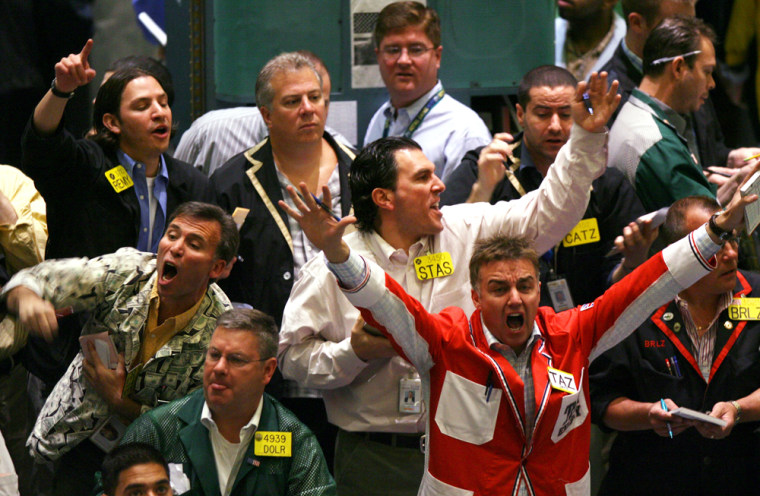Oil prices continued to march higher this week, again hitting record levels Friday before easing slightly. And with the global economy demanding more oil every day to fuel rapid growth, and oil producers struggling to expand supplies, the upward pressure on prices shows no signs of letting up.
Futures contracts for light, sweet crude, available for delivery within a month, changed hands on the New York Mercantile Exchange for $75 a barrel, extending a run that has lifted prices significantly in the past month.
The sources of the upward price pressure are varied. For starters, the world's thirst for oil seems to be undiminished by rising prices. On the eve of President Hu Jintao’s U.S. visit, for example, China announced that its red hot economy had grown by more than 10 percent in the fourth quarter — stronger than expected. That’s more than twice as fast the U.S. economy, which is posting healthy economic gains of its own.
The world’s demand for more oil comes as supplies are more vulnerable than at any time in the past 30 years. The Organization of Petroleum Exporting Countries, which has long provided global markets with a cushion of extra production capacity, is now pumping as fast as it can. Production facilities by OPEC producers Nigeria and Iraq are under attack by armed insurgents, raising the threat of supply interruptions. Growing tensions with Iran have raised fears that the 4.1 million barrels a day it produces could once again become a political weapon, much as it did when a cutoff of oil after the Iranian revolution of 1979 touched off a spike oil prices and long lines at American gasoline stations.
With multiple pinch points looming, even minor threats to the global oil supply chain can send prices surging.
“If somebody sneezes in any part of the world everybody catches cold.” said Fadel Gheit, an oil industry analyst at Oppenheimer and Co.
Ordinarily, higher commodity prices encourage development of new supplies to take advantage of greater profit potential. As oil prices have risen, so has investment in developing new supplies. But it takes years to bring new supply to market. Despite the billions invested worldwide in new production capacity, those new supplies haven’t come online fast enough to prevent the doubling in crude oil prices over the past two years.
And it remains to be seen whether additional investment will bring down long-term prices. With most of the world's potential new oil finds mapped and explored, discoveries of major new reserves of oil have been few and far between. Some analysts and oil industry veterans believe that most of the world’s cheap oil has already been found.
Higher prices are also supposed to cut demand, and there are some early signs that may be happening. Sales of gas-guzzling SUVs and light trucks have fallen sharply in the U.S.
But overall demand for oil continues to rise. One reason: adjusted for the effects of inflation, oil is still cheaper than it was when prices spiked in 1979 -- to levels over $80 a barrel in today's dollars. And despite the visibility of pump prices, and the outrage they provoke among consumers, the overall impact on the average family budget is still relatively small.
“A 50-cent rise in gasoline still represents less than 1 percent of disposable income,” said Matthew DiFrisco, an analyst who follows the restaurant industry at Thomas Weisel Partners. "So it's roughly about $200 to the average American.”
The same is true for the entire U.S. economy. After the oil shocks of the 1970s, big gains in efficiency -– from homeowners insulating their attics to businesses streamlining supply chains to cut shipping costs -– helped make barrel of oil work harder. Today, it takes about half the oil to produce each dollar of U.S. Gross Domestic Product than it did before the oil price spikes of the the 1970s.
But those statistics are only averages. If you're selling digitally-recorded songs over the Internet, higher oil prices have little impact on your bottom line. If you’re a trucking company or an airline, on the other hand, your profits are getting hammered -– despite the increased business that a growing economy is providing.
“For most airlines, I think all the gains that they're seeing on the revenue side are being wiped out by these high fuel costs," Southwest Airlines CEO Gary Kelly said Thursday.
Like many heavy users of fuel, Southwest has hedged in the futures market, buying oil when prices were lower but taking delivery years in the future -- Kelly said the airline has locked in oil deliveries through 2009.
That’s another big reason impact of the rise in oil prices has been blunted -– so far. When headlines describe oil prices at new highs, that price only applies to oil bought today and delivered in 30 days or less. But much of the oil used by industrial users like refiners or manufacturers has already been bought at a lower price.
That means the price of each barrel left unspoken for on the open market -- bought and sold by speculators as well as end users -– is instantly whipsawed by any news that could have an impact on supply or demand. So even as oil today flows smoothly through the system, with relatively strong reserves in storage, the threat of future supply interruptions can send prices spiking today.
And a part of the price spike ends up the pockets of the investors who are on the winning side of each of those trades.
“All the major investment houses in the world are making huge amounts of profit trading oil futures,” said Gheit. “And guess what? There is no shortage of oil today. This is speculation that is driving this higher.”
